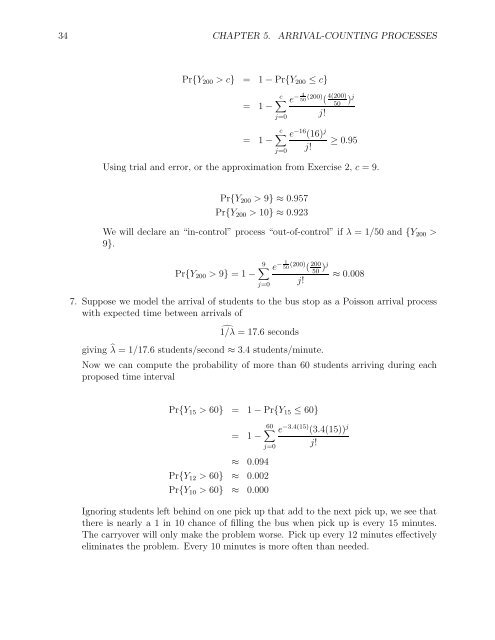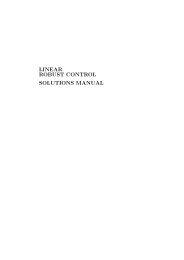SOLUTIONS MANUAL for Stochastic Modeling: Analysis and ...
SOLUTIONS MANUAL for Stochastic Modeling: Analysis and ...
SOLUTIONS MANUAL for Stochastic Modeling: Analysis and ...
Create successful ePaper yourself
Turn your PDF publications into a flip-book with our unique Google optimized e-Paper software.
34 CHAPTER 5. ARRIVAL-COUNTING PROCESSES<br />
Pr{Y 200 >c} = 1− Pr{Y 200 ≤ c}<br />
= 1−<br />
c∑<br />
j=0<br />
e − 4 50 (200) ( 4(200)<br />
50<br />
) j<br />
j!<br />
c∑ e −16 (16) j<br />
= 1−<br />
j!<br />
j=0<br />
≥ 0.95<br />
Using trial <strong>and</strong> error, or the approximation from Exercise 2, c =9.<br />
Pr{Y 200 > 9} ≈0.957<br />
Pr{Y 200 > 10} ≈0.923<br />
We will declare an “in-control” process “out-of-control” if λ =1/50 <strong>and</strong> {Y 200 ><br />
9}.<br />
Pr{Y 200 > 9} =1−<br />
9∑<br />
j=0<br />
e − 1 50 (200) ( 200<br />
50 )j<br />
j!<br />
≈ 0.008<br />
7. Suppose we model the arrival of students to the bus stop as a Poisson arrival process<br />
with expected time between arrivals of<br />
̂1/λ =17.6 seconds<br />
giving ̂λ =1/17.6 students/second ≈ 3.4 students/minute.<br />
Now we can compute the probability of more than 60 students arriving during each<br />
proposed time interval<br />
Pr{Y 15 > 60} = 1− Pr{Y 15 ≤ 60}<br />
= 1−<br />
60 ∑<br />
j=0<br />
≈ 0.094<br />
Pr{Y 12 > 60} ≈ 0.002<br />
Pr{Y 10 > 60} ≈ 0.000<br />
e −3.4(15) (3.4(15)) j<br />
Ignoring students left behind on one pick up that add to the next pick up, we see that<br />
there is nearly a 1 in 10 chance of filling the bus when pick up is every 15 minutes.<br />
The carryover will only make the problem worse. Pick up every 12 minutes effectively<br />
eliminates the problem. Every 10 minutes is more often than needed.<br />
j!















